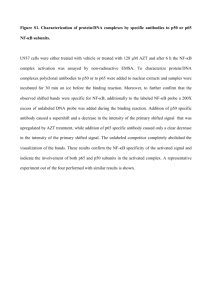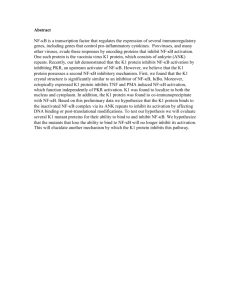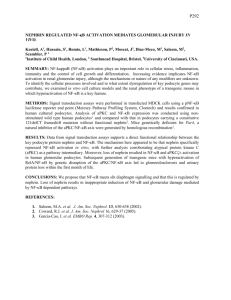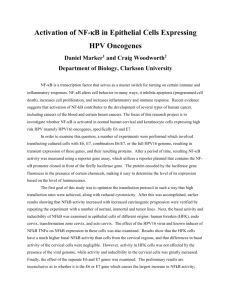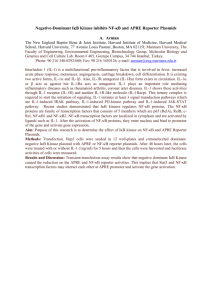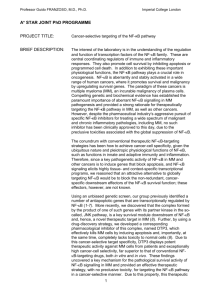In Vivo Imaging of NF- B Activity and Rune Blomhoff
advertisement
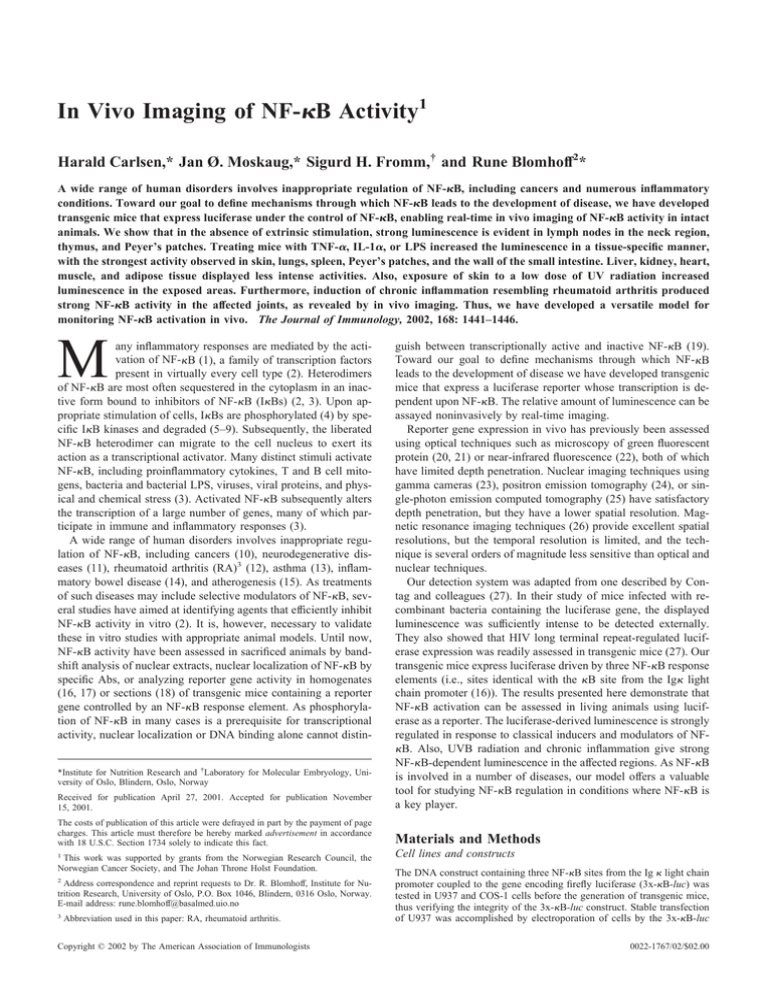
In Vivo Imaging of NF-B Activity1 Harald Carlsen,* Jan Ø. Moskaug,* Sigurd H. Fromm,† and Rune Blomhoff2* A wide range of human disorders involves inappropriate regulation of NF-B, including cancers and numerous inflammatory conditions. Toward our goal to define mechanisms through which NF-B leads to the development of disease, we have developed transgenic mice that express luciferase under the control of NF-B, enabling real-time in vivo imaging of NF-B activity in intact animals. We show that in the absence of extrinsic stimulation, strong luminescence is evident in lymph nodes in the neck region, thymus, and Peyer’s patches. Treating mice with TNF-␣, IL-1␣, or LPS increased the luminescence in a tissue-specific manner, with the strongest activity observed in skin, lungs, spleen, Peyer’s patches, and the wall of the small intestine. Liver, kidney, heart, muscle, and adipose tissue displayed less intense activities. Also, exposure of skin to a low dose of UV radiation increased luminescence in the exposed areas. Furthermore, induction of chronic inflammation resembling rheumatoid arthritis produced strong NF-B activity in the affected joints, as revealed by in vivo imaging. Thus, we have developed a versatile model for monitoring NF-B activation in vivo. The Journal of Immunology, 2002, 168: 1441–1446. Received for publication April 27, 2001. Accepted for publication November 15, 2001. guish between transcriptionally active and inactive NF-B (19). Toward our goal to define mechanisms through which NF-B leads to the development of disease we have developed transgenic mice that express a luciferase reporter whose transcription is dependent upon NF-B. The relative amount of luminescence can be assayed noninvasively by real-time imaging. Reporter gene expression in vivo has previously been assessed using optical techniques such as microscopy of green fluorescent protein (20, 21) or near-infrared fluorescence (22), both of which have limited depth penetration. Nuclear imaging techniques using gamma cameras (23), positron emission tomography (24), or single-photon emission computed tomography (25) have satisfactory depth penetration, but they have a lower spatial resolution. Magnetic resonance imaging techniques (26) provide excellent spatial resolutions, but the temporal resolution is limited, and the technique is several orders of magnitude less sensitive than optical and nuclear techniques. Our detection system was adapted from one described by Contag and colleagues (27). In their study of mice infected with recombinant bacteria containing the luciferase gene, the displayed luminescence was sufficiently intense to be detected externally. They also showed that HIV long terminal repeat-regulated luciferase expression was readily assessed in transgenic mice (27). Our transgenic mice express luciferase driven by three NF-B response elements (i.e., sites identical with the B site from the Ig light chain promoter (16)). The results presented here demonstrate that NF-B activation can be assessed in living animals using luciferase as a reporter. The luciferase-derived luminescence is strongly regulated in response to classical inducers and modulators of NFB. Also, UVB radiation and chronic inflammation give strong NF-B-dependent luminescence in the affected regions. As NF-B is involved in a number of diseases, our model offers a valuable tool for studying NF-B regulation in conditions where NF-B is a key player. The costs of publication of this article were defrayed in part by the payment of page charges. This article must therefore be hereby marked advertisement in accordance with 18 U.S.C. Section 1734 solely to indicate this fact. Materials and Methods 1 Cell lines and constructs M any inflammatory responses are mediated by the activation of NF-B (1), a family of transcription factors present in virtually every cell type (2). Heterodimers of NF-B are most often sequestered in the cytoplasm in an inactive form bound to inhibitors of NF-B (IBs) (2, 3). Upon appropriate stimulation of cells, IBs are phosphorylated (4) by specific IB kinases and degraded (5–9). Subsequently, the liberated NF-B heterodimer can migrate to the cell nucleus to exert its action as a transcriptional activator. Many distinct stimuli activate NF-B, including proinflammatory cytokines, T and B cell mitogens, bacteria and bacterial LPS, viruses, viral proteins, and physical and chemical stress (3). Activated NF-B subsequently alters the transcription of a large number of genes, many of which participate in immune and inflammatory responses (3). A wide range of human disorders involves inappropriate regulation of NF-B, including cancers (10), neurodegenerative diseases (11), rheumatoid arthritis (RA)3 (12), asthma (13), inflammatory bowel disease (14), and atherogenesis (15). As treatments of such diseases may include selective modulators of NF-B, several studies have aimed at identifying agents that efficiently inhibit NF-B activity in vitro (2). It is, however, necessary to validate these in vitro studies with appropriate animal models. Until now, NF-B activity have been assessed in sacrificed animals by bandshift analysis of nuclear extracts, nuclear localization of NF-B by specific Abs, or analyzing reporter gene activity in homogenates (16, 17) or sections (18) of transgenic mice containing a reporter gene controlled by an NF-B response element. As phosphorylation of NF-B in many cases is a prerequisite for transcriptional activity, nuclear localization or DNA binding alone cannot distin*Institute for Nutrition Research and †Laboratory for Molecular Embryology, University of Oslo, Blindern, Oslo, Norway This work was supported by grants from the Norwegian Research Council, the Norwegian Cancer Society, and The Johan Throne Holst Foundation. 2 Address correspondence and reprint requests to Dr. R. Blomhoff, Institute for Nutrition Research, University of Oslo, P.O. Box 1046, Blindern, 0316 Oslo, Norway. E-mail address: rune.blomhoff@basalmed.uio.no 3 Abbreviation used in this paper: RA, rheumatoid arthritis. Copyright © 2002 by The American Association of Immunologists The DNA construct containing three NF-B sites from the Ig light chain promoter coupled to the gene encoding firefly luciferase (3x-B-luc) was tested in U937 and COS-1 cells before the generation of transgenic mice, thus verifying the integrity of the 3x-B-luc construct. Stable transfection of U937 was accomplished by electroporation of cells by the 3x-B-luc 0022-1767/02/$02.00 IN VIVO IMAGING OF NF-B ACTIVITY 1442 plasmid and pMEP4 (Invitrogen, Carlsbad, CA) containing a hygromycin resistance gene. U937 cells or transiently transfected COS-1 cells (28) were incubated with TNF-␣ (5 ng/ml; R&D Systems, Minneapolis, MN), LPS (7–10 g/ml; Sigma, St. Louis, MO), or PMA (50 ng/ml; Sigma) for 3– 4 h. Cells were then harvested and assayed for luciferase enzyme activity as described by the manufacturer (Promega, Madison, WI). Generation of transgenic founder lines was subsequently accomplished using standard techniques of microinjection (29) Generating transgenic mice Generation of transgenic mice following microinjection was largely based on standard techniques described by Hogan and colleagues (29). Briefly, (C57 BL/6J ⫻ CBA/J)F1 females were superovulated and mated overnight with F1 males to yield fertilized zygotes. Pronuclei of zygotes were injected with the 3x-B-luc plasmid linearized with HindIII and BglI (giving a product of ⬃4.5 kb). Surviving zygotes were transferred to pseudopregnant CD-1 recipients. Of 45 offspring (F0), seven tested positive for 3x-B-luc by PCR genotyping. The F1 generation was subsequently analyzed for transgene expression. The founder, named tgH24, was chosen for further studies and was crossed with wild-type F1 mice. All subsequent transgenic offspring were crossed with wild-type F1 to yield only 3x-B-luc heterozygous mice with the (C57BL/6J ⫻ CBA/J) genetic background. quantified by spectrophotometry, reading absorbance at 450 nm. Lysis buffer was used as a negative control. Results NF-B-dependent luminescence in untreated transgenic mice To monitor constitutive NF-B activity D-luciferin was injected i.v., and the mice were placed on their back in a light-sealed chamber and imaged as described (Fig. 1A). Strong luminescence was detected in two small areas in the neck, and an intense signal was often emitted from one or several small spots in the abdominal area (Fig. 1B). In addition, there were weaker and more diffuse signals observed in the thoracic and abdominal regions. When internal organs were exposed before imaging, it was evident that the strong luminescence in the neck was associated with lymph nodes, the thoracic signal originated from thymus, and the abdominal high Animal experiments The following compounds were used to induce NF-B activity by i.v. injection in the tail vein: mouse TNF-␣ (4 – 8 g/kg; R&D Systems), mouse IL-1␣ (4 g/kg; R&D Systems), LPS (Escherichia coli serotype 055:B5, 2 mg/kg; Sigma). UVB-induced NF-B activity was obtained with a transgenic mouse treated with depilatory cream (Veet, London, U.K.) on the ventral side. The skin was treated with cream two or three times for 3– 4 min until fur was removed from the desired area. Aluminum foil with three small holes covered the skin, permitting localized exposure to UVB light from a lamp fitted with a filter permeant to radiation in the UVB range (296 nm, 1-min exposure at 6 W/m2). Chronic inflammation was induced by injecting Abs against collagen type II (4 mg/kg; Stratagene, La Jolla, CA) i.v. into transgenic mice on day 0, followed by injection of LPS (50 g; Sigma) i.v. on day 3. Criteria for the presence of inflammation in the paws were redness, stiffness, and swelling. All animal experiments were performed according to national guidelines for animal welfare. Imaging and luciferase measurements Imaging of transgenic mice was performed with an ultrasensitive camera consisting of an image intensifier coupled to a CCD camera (C2400-47 Hamamatsu, Stockholm, Sweden) fitted with a 25-mm macro lens (Schneideroptics, Hauppauge, NY). Before imaging mice were anesthetized (Hypnorm/Dormicum; Janssen, Beerse, Belgium; Roche, Basel, Switzerland) and either treated with depilatory cream on the ventral side (Veet) or the skin and abdominal muscle was removed to expose internal organs. D-Luciferin (120 mg/kg; Biothema, Dalarö, Sweden) dissolved in 200 l PBS, pH 7.8, was injected i.v. in the tail vein. Immediately afterward the mice were placed in a light-sealed chamber connected to the ultrasensitive camera as described. Gray scale images were obtained before luminescence imaging for reference. Luminescence emitted from the mouse was integrated for 10 min starting 2 min after the injection of luciferin. Individual organs to be imaged were excised from the mice 3 min following i.v. injection of D-luciferin (120 mg/kg). Organs were then placed in a culture dish and immediately imaged as described. Relative photon counts from intact organs were related to the weight of the organ, whereas luciferase enzyme activities in homogenates were related to protein concentration (milligrams per milliliter; Bio-Rad, Hercules, CA) in the sample extracts. The luciferase activity in homogenates was assessed according to the manufacturer’s protocol (Promega). The pseudocolored images represent light intensity (white is the strongest, and blue is the weakest). All images were processed with the software Image-Pro Plus 4.0 (Media Cybernetics, Silver Spring, MD) integrated with the HPD-LIS module developed by Hamamatsu. p65/RelA binding assay p65/RelA-DNA binding was assessed according to the manufacturer (Active Motif, Carlsbad, CA). Briefly, tissues were gently homogenized in lysis buffer (50 mg tissue/150 l) and centrifuged (⬃15,000 ⫻ g) to give a clear lysate. Tissue lysate (40 – 60 g protein/ml) was added to wells in microplates coated with oligonucleotides containing binding sites for NF-B and incubated for 1 h. Ab against p65/RelA was then added, followed by addition of secondary p65/RelA Ab-antibody conjugated with HRP to give a color reaction. The degree of p65/RelA DNA binding was FIGURE 1. A, Imaging of transgenic mice was performed with an ultrasensitive camera on anesthetized mice following i.v. injection of D-luciferin (120 mg/kg). Immediately afterward the mice were placed in a light-sealed chamber connected to an image intensifier coupled to a CCD camera fitted with a 25-mm macrolens. Gray scale images were obtained before luminescence imaging for reference. Untreated intact mice (B) and mice with exposed internal organs (C) were imaged for NF-B-dependent luminescence. As shown in C, three areas emitting strong luminescence are outlined. The images presented are superimpositions of the reference image and the pseudocolored luminescence images. Max, maximum; Min, minimum. The Journal of Immunology activities were located in structures identified as Peyer’s patches along the small intestine (Fig. 1C). Assessment of luminescence after induction by proinflammatory agents Treating mice with TNF-␣, IL-1␣, and LPS, all known activators of NF-B signaling (3), increased the luminescence in a time- and region-specific manner (Fig. 2). When luminescence from whole animal and selected regions was quantified, we observed that the thoracic region displayed the highest induction. A number of organs from untreated and LPS-treated mice were then excised and imaged individually (Fig. 3A). In untreated mice thymus displayed strong luminescence. Peyer’s patches also displayed distinct luminescence. Following induction by LPS (2 mg/ kg), luminescence from the other organs was highly increased. The largest activities were observed in skin, lungs, spleen, and the small intestine (i.e., both Peyer’s patches and the intestinal wall), while liver, kidney, heart, muscle, and adipose tissue displayed a less intense activity. The high activity measured in noninduced thymus was largely unchanged following LPS treatment. We made homogenates of excised organs from untreated mice (Table I) and mice treated with TNF-␣ (4 g/kg), IL-1␣ (4 g/kg), or LPS (2 mg/kg; Fig. 3B), and the luciferase activity was quantified with a conventional enzyme assay. In untreated mice thymus was by far the most active organ (luciferase activity expressed per weight unit of protein), followed by spleen, small intestine (i.e., intestinal wall with Peyer’s patches), and skin (Table I and Fig. 3A). In accordance with the results from noninvasive imaging, all treatments induced luciferase activity in several organs. For all treatments the greatest induction was observed in liver and lungs, with a maximum of about 200-fold induction in both organs with LPS. Strong induction of NF-B activity was also observed in kidney by all treatments and in heart, skin, and muscle by IL-1␣ FIGURE 2. TNF-␣ (A), IL-1␣ (B), and LPS (C) induce NF-B-dependent luminescence in living mice. TNF-␣ (4 g/kg), IL-1 ␣ (4 g/kg), and LPS (2 mg/kg) were injected i.v. in the tail vein. The mice were then imaged as described in Fig. 1 after three periods of time. The time points were determined from assessment of luciferase activity in homogenates from various organs. The whole animal, the area covering thymus and lymph nodes, the lower part of thorax, and the abdominal region were outlined and subjected to relative photon counting. Luminescent intensity is related to the relative photon counting in the mice at 0 h. 1443 treatment. Luciferase activity in the thymus was not affected by any of the treatments (data not shown). To demonstrate a correlation between imaging and actual luciferase enzyme activity, organs from LPS-treated mice were excised and imaged, followed by assaying the luciferase enzyme activity in organ extracts (Fig. 3C). In lungs, lymph nodes, heart, kidney, muscle, and liver the luminescence imaged with the camera correlated highly with the luciferase enzyme activity (correlation coefficient r ranged in these organs from 0.877 in liver to 0.99 in lungs). In spleen (r ⫽ 0.68), skin (r ⫽ 0.68), and thymus (r ⫽ 0.56) a less clear correlation was observed, while in intestine no correlation could be observed between the imaged luminescence and the actual luciferase activities. We also observed that luciferase activity determined by whole organ luminescence apparently was quenched more in “dark” organs such as liver, kidney, spleen, and heart compared with more translucent organs such as lungs. This is in accordance with the observation that hemoglobin is the major absorber of visible light, including the light emitted from luciferase (i.e., 520 –570 nm) (30). In addition, organs with a nonuniform distribution of cells expressing luciferase, such as the small intestine and lymph nodes, would be expected to deviate between whole organ imaging and homogenate assay. To verify the model further we compared TNF-␣-induced luciferase expression with induction of p65/RelA DNA binding. One and a half hours after TNF-␣ i.v. injection (8 g/kg) of three mice, DNA binding of p65/RelA was assayed in tissue homogenates (pooled from three mice). p65/RelA binding in liver, spleen, lung, and thymus of TNF-␣-treated mice was 612, 206, 247, and 98% of that in untreated mice, respectively. Thus, up-regulation of p65/ RelA DNA binding and induction of reporter activity are demonstrated in liver, spleen, and lung, but not in thymus, as expected. IN VIVO IMAGING OF NF-B ACTIVITY 1444 FIGURE 3. NF-B-dependent luminescence in individual organs assayed by imaging or luminometry. A, From 4 to 5 h after injection of LPS (2 mg/kg) or PBS, the mice were anesthetized, and luciferin was administered. After 3 min, they were sacrificed by cervical dislocation, and organs were excised rapidly and subjected to imaging. B, TNF-␣ (4 g/kg), IL-1␣ (4 g/kg), or LPS (2 mg/kg) were injected into transgenic mice. Selected organs were excised after the time period giving highest activity for each activator and assayed for luciferase activity. Values are presented as the mean fold induction of luciferase activity (n ⫽ 4). The SD is indicated. C, Five hours after treatment with LPS (2 mg/kg), selected organs from four male mice were rapidly excised and imaged, followed by snap-freezing of the organ for subsequent luciferase enzyme assay. Relative photon counts from intact organs are related to the weight of the organ, whereas luciferase (LUC) enzyme activity in homogenates is related to protein concentration (milligrams per milliliter) in the sample extracts. Data are presented as mean values; the SD is indicated (n ⫽ 4). Effect of dexamethasone on NF-B-regulated luminescence UVB-induced luminescence in skin To further demonstrate the modulation of NF-B activity in the transgenic mice by the in vivo imaging technique, LPS-induced transgenic mice were pretreated with dexamethasone (0.45 or 4.5 mg/kg), a wellknown suppressor of NF-B activity (2, 31, 32). As demonstrated in Fig. 4, whole body imaging of living mice revealed that 0.45 and 4.5 mg dexamethasone/kg reduced the total luminescence from the animal by 15 and 45% (mean of three mice in each group), respectively. NF-B has been implicated in development of UV-induced skin inflammation and cancer (33, 34). Assessment of NF-B in the skin as a function of UV radiation is therefore of great interest. To test whether UVB light (296 nm, 1 min exposure at 6 W/m2) induced NF-B activity in skin of transgenic mice, we exposed defined regions of the mice to a dose of UVB defined to be the lowest dose able to induce redness of human skin (minimal erythema dose, 360 J/cm2). As shown in Fig. 5, UVB strongly induce the NF-B-driven luciferase activity in the exposed areas. The UVBmediated increase was first observed after 3.5 h. After 6.5 h the activity had increased 6-fold relative to background. After 24 h the activity reached a maximum (34-fold induction) while declining significantly after 48 h. Significant induction of NF-B was observed in regions exposed to doses as low as 100 J/cm2 (data not shown). This is in agreement with earlier in vitro observations of increased NF-B binding to DNA in EMSAs (35). Table I. Luciferase activity in selected tissue from 3x-B-luc-transgenic mice treated with saline (control) Tissue Luciferase Activity (arb. U) SD Liver Spleen Lungs Kidney Heart Skin Muscle Thymus Intestine 0.05 7.45 0.28 0.11 0.13 2.30 0.27 120 7.3 0.005 4.453 0.118 0.055 0.115 1.544 0.163 71.68 0.665 NF-B regulated luminescence in arthritis affected joints During chronic inflammations such as RA NF-B mediates TNF␣-induced expression of a number of cytokines (e.g., IL-8 and IL-6) (12). A number of studies have also shown an increased activity of NF-B in cultured synoviocytes from patients with RA (36), and that NF-B has an increased DNA binding activity in The Journal of Immunology 1445 FIGURE 4. LPS-induced NF-B activity is reduced by dexamethasone (Dex). A, Transgenic mice were pretreated with either dexamethasone (0.45 or 4.5 mg/kg i.v.) dissolved in saline containing 6% DMSO or in saline with 6% DMSO alone (control). One hour later LPS (2 mg/kg) was given to all animals by i.v. injection. Five to six hours after the LPS injection skin was removed from the abdominal part of the animal, and the photons from the whole animal were counted. Values are expressed as the mean luminescence normalized to the control value from three mice. The SD is indicated. B, Images of one representative mouse from the control group (LPS alone) and one from the group pretreated with the highest concentration of dexamethasone followed by LPS are presented. synovial membranes of RA patients (37). Furthermore, recent studies indicate that reduction of NF-B activity by overexpression of the inhibitory subunit IB␣ in rheumatoid synovial tissue inhibits the inflammatory process and mechanisms of tissue destruction (38). To test whether NF-B-driven luciferase activity in transgenic mice also responds during inflammatory processes, we induced chronic inflammation in the mouse at particular sites, mimicking development of RA, by injecting Abs against collagen type II and LPS as described by Terato et al. (39). The right front paw of the injected mouse developed redness and pronounced swelling typical for arthritic joints. Video imaging of the affected joint exhibited increased luminescence after induction of arthritis (Fig. 6). Quantification of the signal demonstrated a 7-fold induction of NF-B activity in the arthritic joint compared with the paw in an animal treated only with LPS. Discussion In this study we have been able to monitor changes in NF-B activity in living animals as a function of cytokines, endotoxin, physical agent, and state of disease. While previous in vivo imaging studies of gene expression have studied the constitutive activity of complete promoters (i.e., the transferrin receptor (26) and the viral promoters HIV long terminal repeat and CMV (20, 27, 40)) we have demonstrated the dynamic activity of a single response element. The experiments are in agreement with earlier in vitro observations of increased NF-B binding to DNA in EMSAs and nuclear immunolocalization of NF-B following TNF-␣, IL-1␣, and LPS treatment as well as UVB treatment and also increased activity in affected joints in the RA model. Most importantly, our experiments demonstrate modulation of trans-activation, which is not always a consequence of DNA binding or nuclear localization (19). Additionally, the model circumvents limitations in analyses of reporter activity in sections and homogenates as required in other transgenic animal models (16, 18). It also to some extent provides sensitivity, and spatial and temporal resolution compared with tomography imaging techniques (24, 25) and magnetic resonance FIGURE 5. In vivo assessment of UVB-induced NF-B activity. A, Three small areas on the skin were exposed to a UVB dose (296 nm) corresponding to one human erythema dose (MED; 360 J/cm2). After defined periods of time the animal was anesthetized, luciferin was injected, and luminescence in the three exposed areas was imaged using the camera as described in Fig. 1. The UVB-exposed areas are overlaid the reference image. B, Luminescence in the exposed areas was analyzed by computer software as described and is presented as fold induction compared with luciferase activity in similar areas adjacent to the exposed areas. Each UV-exposed area is normalized to the adjacent unexposed area (control). Data represent the mean of the relative value from the three exposed areas. The SD is indicated. imaging (26). Although activity from thymus, lymph nodes, and intestine can be clearly distinguished through the skin as illustrated in Fig. 1B, the model may be most useful for imaging NF-B activity in structures in close proximity to the surface such as skin and joints in extremities (Figs. 5 and 6). The relatively short halflife (t1/2, ⬃2–3 h) and the lack of post-translational modifications of expressed luciferase reporter also provide the necessary dynamics to monitor NF-B regulation close to real-time. Drugs modulating NF-B is needed for treatment in a number of diseases. Our transgenic mouse model enabling in vivo imaging of luciferase reporter may be useful for screening potential candidate drugs for the treatment of inflammatory conditions associated with aberrant NF-B activation. We propose that similar transgenic models using other response elements or complete promoters may serve as a general model to monitor gene expression in vivo and to screen exogenous factors, such as nutrients, pharmaceuticals, and pollutants, for modulation of gene expression. 1446 FIGURE 6. Assessment of NF-B activity induced by chronic inflammation. A, Abs against collagen type II (4 mg/kg) was injected i.v. into transgenic mice on day 0, followed by injection of LPS (50 g) i.v. on day 3. After verification of arthritis development in the front paw (swelling, stiffness, and redness) luciferin was injected i.v. at the days indicated in the figure, and luciferase activity was assessed using the camera as described in Fig. 1. B, On the days indicated, luminescence from the arthritic paw was quantified and compared with luminescence from the equivalent paw of a mouse that had been treated only with LPS (50 g) on day 3. The graph shows fold induction of luminescence as a function of time in the arthritic paw and the control paw related to luminescence in the respective paws on day 0. Acknowledgments We thank T. Wirth for providing the 3x-B-luc plasmid, R. A. Davis for valuable comments on the manuscript, K. Holte and L. Andersen for technical assistance, and K. Hollung and I. Brude for providing the stably transfected U937 cells. References 1. Sen, R., and D. Baltimore. 1986. Multiple nuclear factors interact with the immunoglobulin enhancer sequences. Cell 46:705. 2. Baldwin, A. S., Jr. 1996. The NF-B and IB proteins: new discoveries and insights. Annu. Rev. Immunol. 14:649. 3. Siebenlist, U., G. Franzoso, and K. Brown. 1994. Structure, regulation and function of NF-B. Annu. Rev. Cell Biol. 10:405. 4. Brown, K., S. Gerstberger, L. Carlson, G. Franzoso, and U. Siebenlist. 1995. Control of IB-␣ proteolysis by site-specific, signal-induced phosphorylation. Science 267:1485. 5. Woronicz, J. D., X. Gao, Z. Cao, M. Rothe, and D. Goeddel. 1997. IB kinase-: NF-B activation and complex formation with IB kinase-␣ and NIK. Science 278:866. 6. Zandi, E., D. M. Rothwarf, M. Delhase, M. Hayakawa, and M. Karin. 1997. The IB kinase complex (IKK) contains two kinase subunits, IKK␣ and IKK, necessary for IB phosphorylation and NF-B activation. Cell 91:243. 7. Regnier, C. H., and H. Y. Song. 1997. Identification and characterization of an IB-kinase. Cell 90:373. 8. Mercurio, F., H. Zhu, B. Murray, A. Shevchenko, B. Bennet, J. Li, D. Young, M. Barbosa, M. Mann, A. Manning, et al. 1997. IKK-1 and IKK-2: cytokineactivated IB kinases essential for NF-B activation. Science 278:860. 9. DiDonato, J. A., M. Hayakawa, D. M. Rothwarf, E. Zandi, and M. Karin. 1997. A cytokine-responsive IB kinase that activates the transcription factor NF-B. Nature 388:548. 10. Gilmore, T. D., M. Koedood, K. A. Piffat, and D. W. White. 1996. Rel/NF-B/ IB proteins and cancer. Oncogene 13:1367. 11. O’Neill, L., and C. Kaltschmidt. 1997. NF-B: a crucial transcription factor for glial and neuronal cell function. Trends Neurosci. 20:252. IN VIVO IMAGING OF NF-B ACTIVITY 12. Feldmann, M., F. M. Brennan, and R. N. Maini. 1996. Rheumatoid arthritis. Cell 85:307. 13. Barnes, P. J., and I. M. Adcock. 1998. Transcription factors and asthma. Eur. Respir. J. 12:221. 14. Neurath, M. F., C. Becker, and K. Barbulescu. 1998. Role of NF-B in immune and inflammatory responses in the gut. Gut 43:856. 15. Brand, K., S. Page, A. K. Walli, D. Neumeier, and P. A. Baeuerle. 1997. Role of nuclear factor-B in atherogenesis. Exp. Physiol. 82:297. 16. Lernbecher, T., U. Muller, and T. Wirth. 1993. Distinct NF-B/Rel transcription factors are responsible for tissue-specific and inducible gene activation. Nature 365:767. 17. Blackwell, T. S., F. E. Yull, C. L. Chen, A. Venkatakrishnan, T. R. Blackwell, D. J. Hicks, L. H. Lancaster, J. W. Christman, and L. D. Kerr. 2000. Multiorgan nuclear factor B activation in a transgenic mouse model of systemic inflammation. Am. J. Respir. Crit. Care Med. 162:1095. 18. Schmidt-Ullrich, R., S. Memet, A. Lilienbaum, J. Feuillard, M. Raphael, and A. Israel. 1996. NF-B activity in transgenic mice: developmental regulation and tissue specificity. Development 122:2117. 19. Sizemore, N., S. Leung, and G. R. Stark. 1999. Activation of phosphatidylinositol 3-kinase in response to interleukin-1 leads to phosphorylation and activation of the NF-B p65/RelA subunit. Mol. Cell. Biol. 19:4798. 20. Yang, M., E. Baranov, A. R. Moossa, S. Penman, and R. M. Hoffman. 2000. Visualizing gene expression by whole-body fluorescence imaging. Proc. Natl. Acad. Sci. USA 97:12278. 21. Yang, M., E. Baranov, P. Jiang, F. X. Sun, X. M. Li, L. Li, S. Hasegawa, M. Bouvet, M. Al-Tuwaijri, T. Chishima, et al. 2000. Whole-body optical imaging of green fluorescent protein-expressing tumors and metastases. Proc. Natl. Acad. Sci. USA 97:1206. 22. Weissleder, R., C. H. Tung, U. Mahmood, and A. Bogdanov, Jr. 1999. In vivo imaging of tumors with protease-activated near-infrared fluorescent probes. Nat. Biotechnol. 17:375. 23. Tjuvajev, J. G., G. Stockhammer, R. Desai, H. Uehara, K. Watanabe, B. Gansbacher, and R. G. Blasberg. 1995. Imaging the expression of transfected genes in vivo. Cancer Res. 55:6126. 24. Gambhir, S. S., J. R. Barrio, M. E. Phelps, M. Iyer, M. Namavari, N. Satyamurthy, L. Wu, L. A. Green, E. Bauer, D. C. MacLaren, et al. 1999. Imaging adenoviral-directed reporter gene expression in living animals with positron emission tomography. Proc. Natl. Acad. Sci. USA 96:2333. 25. Tjuvajev, J. G., R. Finn, K. Watanabe, R. Joshi, T. Oku, J. Kennedy, B. Beattie, J. Koutcher, S. Larson, and R. G. Blasberg. 1996. Noninvasive imaging of herpes virus thymidine kinase gene transfer and expression: a potential method for monitoring clinical gene therapy. Cancer Res. 56:4087. 26. Weissleder, R., A. Moore, U. Mahmood, R. Bhorade, H. Benveniste, E. A. Chiocca, and J. P. Basilion. 2000. In vivo magnetic resonance imaging of transgene expression. Nat. Med. 6:351. 27. Contag, P. R., I. N. Olomu, D. K. Stevenson, and C. H. Contag. 1998. Bioluminescent indicators in living mammals. Nat. Med. 4:245. 28. Natarajan, V., K. B. Holven, S. Reppe, R. Blomhoff, and J. O. Moskaug. 1996. The C-terminal RNLL sequence of the plasma retinol-binding protein is not responsible for its intracellular retention. Biochim. Biophys. Acta 221:374. 29. Hogan, B., R. Beddington, F. Constantini, and E. Lacy. 1994. Manipulating the Mouse Embryo. Cold Spring Harbor Laboratory Press, Woodbury, NY. 30. Weissleder, R. 2001. A clearer vision for in vivo imaging. Nat. Biotechnol. 19: 316. 31. Kopp, E., and S. Ghosh. 1994. Inhibition of NF-B by sodium salicylate and aspirin. Science 265:956. 32. Yin, M. J., Y. Yamamoto, and R. B. Gaynor. 1998. The anti-inflammatory agents aspirin and salicylate inhibit the activity of I()B kinase-. Nature 396:77. 33. Budunova, I. V., P. Perez, V. R. Vaden, V. S. Spiegelman, T. J. Slaga, and J. L. Jorcano. 1999. Increased expression of p50-NF-B and constitutive activation of NF-B transcription factors during mouse skin carcinogenesis. Oncogene 18:7423. 34. van Hogerlinden, M., B. L. Rozell, L. Ahrlund-Richter, and R. Toftgard. 1999. Squamous cell carcinomas and increased apoptosis in skin with inhibited Rel/ nuclear factor-B signaling. Cancer Res. 59:3299. 35. Tobin, D., M. van Hogerlinden, and R. Toftgard. 1998. UVB-induced association of tumor necrosis factor (TNF) receptor 1/TNF receptor-associated factor-2 mediates activation of Rel proteins. Proc. Natl. Acad. Sci. USA 95:565. 36. Miyazawa, K., A. Mori, K. Yamamoto, and H. Okudaira. 1998. Constitutive transcription of the human interleukin-6 gene by rheumatoid synoviocytes: spontaneous activation of NF-B and CBF1. Am. J. Pathol. 152:793. 37. Asahara, H., M. Asanuma, N. Ogawa, S. Nishibayashi, and H. Inoue. 1995. High DNA-binding activity of transcription factor NF-B in synovial membranes of patients with rheumatoid arthritis. Biochem. Mol. Biol. Int. 37:827. 38. Bondeson, J., B. Foxwell, F. Brennan, and M. Feldmann. 1999. Defining therapeutic targets by using adenovirus: blocking NF-B inhibits both inflammatory and destructive mechanisms in rheumatoid synovium but spares antiinflammatory mediators. Proc. Natl. Acad. Sci. USA 96:5668. 39. Terato, K., D. S. Harper, M. M. Griffiths, D. L. Hasty, X. J. Ye, M. A. Cremer, and J. M. Seyer. 1995. Collagen-induced arthritis in mice: synergistic effect of E. coli lipopolysaccharide bypasses epitope specificity in the induction of arthritis with monoclonal antibodies to type II collagen. Autoimmunity 22:137. 40. Yu, Y., A. J. Annala, J. R. Barrio, T. Toyokuni, N. Satyamurthy, M. Namavari, S. R. Cherry, M. E. Phelps, H. R. Herschman, and S. S. Gambhir. 2000. Quantification of target gene expression by imaging reporter gene expression in living animals. Nat. Med. 6:933.
